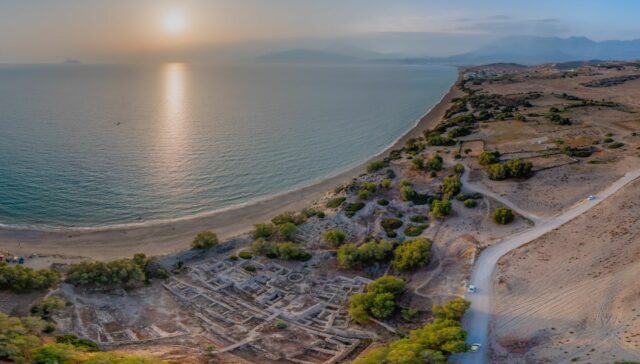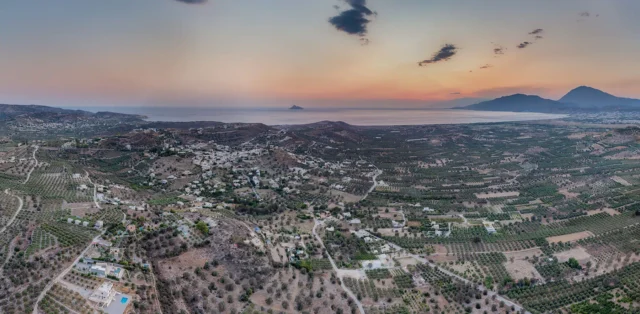



Kommos Archaeological Site: Unveiling a Minoan Port Town
A Haven on Crete’s Southern Coast
The Kommos archaeological site, situated on the southern coast of central Crete, offers a fascinating glimpse into the Minoan civilization, which flourished on the island from approximately 2700 to 1450 BC. Although excavations are ongoing, the unearthed structures and artifacts vividly portray a bustling port town that played a crucial role in Minoan trade and maritime activities.
Strategic Gateway to the Mesara Plain
Kommos’s strategic location on the fertile Mesara Plain, a major Minoan population center, positioned it as a key hub for maritime trade. The site’s proximity to the significant Minoan palace of Phaistos, located a few kilometers inland, further enhanced its importance as a gateway for the region’s agricultural produce and artisanal crafts.
Unearthing a Minoan Hub
Systematic excavations at Kommos commenced in 1976, led by University of Toronto archaeologists Joseph Shaw and Maria Shaw. Their meticulous work has yielded a wealth of discoveries, illuminating the site’s diverse functions and providing insights into the daily lives of its inhabitants. The Kommos Conservancy, a non-profit organization established in 2007, actively supports these ongoing excavations and champions the preservation and educational interpretation of the site.
A Bustling Minoan Port
Central to Kommos is a remarkable complex that once functioned as the Minoan port. This area features substantial storage facilities, workshops, and a network of paved roads that facilitated the efficient movement of goods. The presence of imported pottery and artifacts from across the Mediterranean attests to Kommos’s dynamic role in international trade, connecting Crete with the wider ancient world.
Cradle of Minoan Shipbuilding
Kommos holds the unique distinction of being the first site in Crete to provide evidence of Minoan shipbuilding activities. The remnants of a large building, potentially a ship shed, suggest that the town actively participated in the construction and maintenance of seafaring vessels. This discovery underscores the Minoans’ advanced maritime technology and their reliance on the sea for trade and communication, showcasing their seafaring capabilities.
Enduring Legacy: Beyond the Minoans
Even after the decline of the Minoan civilization, Kommos remained inhabited. During the Hellenistic period, a sanctuary dedicated to various deities, including Menelaus, was constructed atop the Minoan ruins. The presence of this sanctuary emphasizes the site’s continued importance as a sacred and ceremonial center throughout different historical periods. The Kommos Conservancy is actively engaged in the preservation and conservation of these structures, ensuring their protection and accessibility for future generations.
A Glimpse into the Past
Although Kommos is still partially unexcavated and currently closed to the public, visitors can appreciate the site’s grandeur from the nearby beach. Plans are in motion to further develop the site for public access, ensuring that this invaluable repository of Minoan history remains accessible and appreciated by future generations. The Kommos Conservancy is dedicated to realizing these plans and creating an engaging and educational experience for visitors, allowing them to connect with the rich history of the site.
Intriguing Discoveries Beyond the Main Excavations
Recent archaeological investigations have brought to light additional points of interest at Kommos:
- The Villa of the Olive Press: This remarkable Minoan residence features a well-preserved olive press, offering valuable insights into the production of olive oil, a crucial commodity in Minoan society.
- The Peak Sanctuary: Situated on the hill overlooking the site, this sanctuary provides breathtaking panoramic views of the surrounding landscape and the sea, offering a glimpse into the spiritual practices of the Minoans.
- Kommos Beach: The pristine beach adjacent to the archaeological site provides a serene and picturesque setting for relaxation and reflection after exploring the ancient ruins.
Kommos: A Legacy of Minoan Brilliance
The archaeological site of Kommos stands as a testament to the ingenuity, maritime prowess, and global connections of the Minoan civilization. Its ongoing excavation and future development, spearheaded by dedicated archaeologists and organizations like the Kommos Conservancy, promise to further unravel the mysteries of this captivating chapter in human history. Kommos offers invaluable insights into the lives, trade networks, and cultural achievements of the ancient Minoans, inviting us to connect with their legacy and appreciate their remarkable contributions to the development of human civilization.
Preserving Kommos: The Crucial Role of the Kommos Conservancy
The Kommos Conservancy, a non-profit organization, plays a pivotal role in safeguarding and promoting the Kommos archaeological site. Their multifaceted approach encompasses various aspects of preservation, research, and public engagement, ensuring the site’s long-term sustainability and accessibility.
Conservation and Preservation
The Conservancy actively supports the ongoing excavations at Kommos, collaborating with archaeologists and researchers to uncover and document the site’s rich history. They also prioritize the conservation and preservation of the unearthed structures and artifacts, implementing measures to protect them from environmental degradation and ensuring their longevity for future generations to appreciate and study.
Educational Outreach and Public Engagement
The Kommos Conservancy is committed to fostering public understanding and appreciation of the site’s significance. They organize educational programs, workshops, and guided tours, providing opportunities for visitors to delve deeper into the Minoan civilization and its maritime heritage. The Conservancy also maintains an informative website and social media presence, disseminating knowledge about Kommos and its ongoing research to a wider audience.
Future Development and Accessibility
Recognizing the importance of public access, the Conservancy is actively involved in plans to develop the site further, making it more accessible and engaging for visitors. This includes creating interpretive trails, signage, and visitor facilities, while ensuring the preservation of the site’s archaeological integrity. The Conservancy envisions Kommos as a vibrant cultural destination where visitors can experience the wonders of the Minoan civilization firsthand.
The 2015 Conservation Plan: A Blueprint for Preservation
The 2015 Conservation and Development Plan Update for the Kommos Archaeological Site, prepared by James Stratis for the Kommos Conservancy, serves as a crucial roadmap for the site’s preservation and future development. This comprehensive plan outlines various strategies and recommendations to address the challenges facing the site and ensure its long-term sustainability.
Key Challenges and Solutions
The 2015 plan identifies several key challenges impacting the preservation of Kommos, including:
- Drainage Control and Erosion: The plan addresses issues related to surface water drainage, erosion, and alluvium deposition, proposing solutions such as the installation of a concrete-lined swale and the stabilization of the western perimeter. The 2020 reconnaissance report by James Stratis, however, highlights the ongoing threat of erosion, particularly on the seashore (west) side of the site, endangering the southwestern portion. It underscores the urgent need to implement stabilization measures in this area.
- Wind Control and Aeolian Sand Deposition: The plan outlines strategies to mitigate the effects of wind erosion and sand deposition, including the re-establishment
Seems abandoned
What a waste!
Archelogical site - unfortunatelly closed
This was the harbor of the palace of Pheistos thousands of years ago.
You can still see this in the drone footage.
The water there is very clear.


































There are no comments yet.